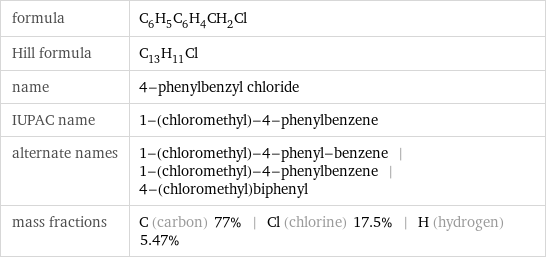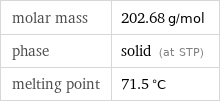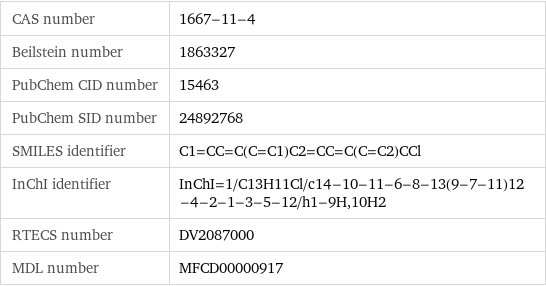Input interpretation

4-phenylbenzyl chloride
Chemical names and formulas

formula | C_6H_5C_6H_4CH_2Cl Hill formula | C_13H_11Cl name | 4-phenylbenzyl chloride IUPAC name | 1-(chloromethyl)-4-phenylbenzene alternate names | 1-(chloromethyl)-4-phenyl-benzene | 1-(chloromethyl)-4-phenylbenzene | 4-(chloromethyl)biphenyl mass fractions | C (carbon) 77% | Cl (chlorine) 17.5% | H (hydrogen) 5.47%
Lewis structure

Draw the Lewis structure of 4-phenylbenzyl chloride. Start by drawing the overall structure of the molecule, ignoring potential double and triple bonds: Count the total valence electrons of the carbon (n_C, val = 4), chlorine (n_Cl, val = 7), and hydrogen (n_H, val = 1) atoms: 13 n_C, val + n_Cl, val + 11 n_H, val = 70 Calculate the number of electrons needed to completely fill the valence shells for carbon (n_C, full = 8), chlorine (n_Cl, full = 8), and hydrogen (n_H, full = 2): 13 n_C, full + n_Cl, full + 11 n_H, full = 134 Subtracting these two numbers shows that 134 - 70 = 64 bonding electrons are needed. Each bond has two electrons, so in addition to the 26 bonds already present in the diagram add 6 bonds. To minimize formal charge carbon wants 4 bonds. Identify the atoms that want additional bonds and the number of electrons remaining on each atom: Fill in the 6 bonds by pairing electrons between adjacent highlighted atoms. Note that the six atom rings are aromatic, so that the single and double bonds may be rearranged: Answer: | |
3D structure

3D structure
Basic properties

molar mass | 202.68 g/mol phase | solid (at STP) melting point | 71.5 °C
Units

Chemical identifiers

CAS number | 1667-11-4 Beilstein number | 1863327 PubChem CID number | 15463 PubChem SID number | 24892768 SMILES identifier | C1=CC=C(C=C1)C2=CC=C(C=C2)CCl InChI identifier | InChI=1/C13H11Cl/c14-10-11-6-8-13(9-7-11)12-4-2-1-3-5-12/h1-9H, 10H2 RTECS number | DV2087000 MDL number | MFCD00000917